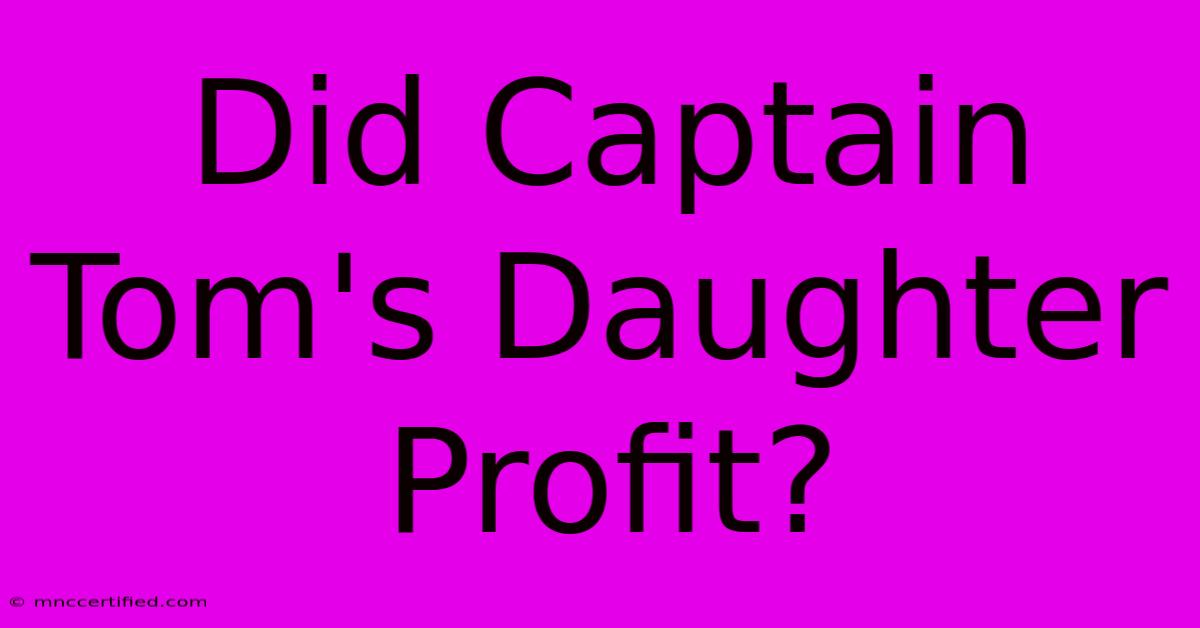Did Captain Tom's Daughter Profit?

Table of Contents
Did Captain Tom Moore's Daughter Profit From His Charity Work? Examining the Controversy
The late Captain Sir Tom Moore, a national hero in the UK, raised millions for the NHS during the COVID-19 pandemic. However, his charitable efforts were later overshadowed by controversy surrounding the financial dealings of his family, particularly his daughter, Hannah Ingram-Moore. This article delves into the accusations and examines the evidence to determine whether she profited from her father's fundraising.
The Captain Tom Foundation: A Legacy Tarnished?
Captain Tom Moore's fundraising initially garnered widespread praise and admiration. His walk around his garden, raising money for the NHS Charities Together, captured the hearts of millions. The Captain Tom Foundation was subsequently established to continue his charitable work, with Hannah Ingram-Moore playing a significant role.
However, investigations by the Charity Commission revealed several concerning issues, leading to accusations of potential conflicts of interest and financial irregularities. These investigations focused on several key areas, fueling the debate about whether Hannah Ingram-Moore personally profited from her father's legacy.
Key Accusations and Findings:
- High salaries and expenses: The Charity Commission scrutinized the salaries paid to individuals associated with the foundation, including Hannah Ingram-Moore and her husband, Colin Ingram. Reports emerged detailing significant expenses, sparking public concern about potential misuse of funds.
- Lack of transparency and governance: Criticisms were leveled against the foundation's governance structure, with concerns about a lack of transparency in financial dealings. This fueled speculation about potential personal enrichment at the expense of charitable donations.
- Conflict of interest: Hannah Ingram-Moore's involvement in various commercial ventures related to her father's legacy raised questions about potential conflicts of interest. These ventures included books, documentaries, and merchandise, blurring the lines between charitable work and personal gain.
It's crucial to note that while the Charity Commission investigation revealed serious governance failings, it did not definitively conclude that Hannah Ingram-Moore personally profited illegally. The investigation focused on the overall management and financial practices of the foundation, highlighting systemic issues rather than direct accusations of personal enrichment.
The Public's Perception and the Media's Role:
The media played a significant role in shaping public perception of Hannah Ingram-Moore's involvement. Intense scrutiny and negative press coverage fueled public anger and distrust, leading many to believe she unjustly profited from her father's charity work.
This intense media attention highlights the importance of transparency and accountability in charitable organizations. The Captain Tom Foundation case serves as a cautionary tale, emphasizing the need for robust governance structures and clear ethical guidelines to prevent similar controversies in the future.
Conclusion: A Complex Picture
Determining whether Hannah Ingram-Moore directly profited from her father's charity work remains a nuanced question. While the Charity Commission investigation highlighted significant failings within the foundation's management, it didn't definitively prove personal enrichment. However, the perception of potential conflict of interest and the lack of transparency have undeniably damaged the legacy of Captain Tom Moore and left a lingering question mark regarding the ethical handling of his charitable fundraising efforts. The case serves as a reminder of the vital importance of ethical conduct and transparency in all charitable ventures. Further independent investigations and public accountability remain crucial for restoring trust and ensuring future charitable endeavors are managed responsibly.

Thank you for visiting our website wich cover about Did Captain Tom's Daughter Profit?. We hope the information provided has been useful to you. Feel free to contact us if you have any questions or need further assistance. See you next time and dont miss to bookmark.
Featured Posts
-
Former Red Sox Pitcher Sale Wins Cy Young
Nov 22, 2024
-
Oscar Insurance Vision Providers
Nov 22, 2024
-
Bengals Steelers Pratt Predicts Win
Nov 22, 2024
-
Dental Insurance For Gum Disease
Nov 22, 2024
-
Reverend Coles Partner A Tragic Loss
Nov 22, 2024